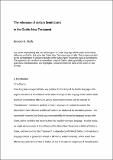Files in this item
The relevance of certain Semiticisms in the Gothic New Testament
Item metadata
| dc.contributor.author | Wolfe, Brendan N. | |
| dc.date.accessioned | 2018-09-30T23:50:51Z | |
| dc.date.available | 2018-09-30T23:50:51Z | |
| dc.date.issued | 2018-09-01 | |
| dc.identifier | 252168592 | |
| dc.identifier | 05fa488f-2d83-4f0e-beb5-25544df80dbe | |
| dc.identifier | 85049163880 | |
| dc.identifier | 000452557500009 | |
| dc.identifier.citation | Wolfe , B N 2018 , ' The relevance of certain Semiticisms in the Gothic New Testament ' , NOWELE | North-Western European Language Evolution , vol. 71 , no. 2 , pp. 249-256 . https://doi.org/10.1075/nowele.00015.wol | en |
| dc.identifier.issn | 0108-8416 | |
| dc.identifier.uri | https://hdl.handle.net/10023/16116 | |
| dc.description.abstract | It is worth emphasizing that it is not the generic Greek language which exerts Hellenizing influence on Gothic, but rather the Greek New Testament specifically. This is demonstrated by the consideration of unGreek features of the Greek New Testament, such as Semiticisms. This approach also resolves an anomalous usage of Gothic jabai, generally unexplained in grammars and dictionaries, and highlights a departure from the sense of the Greek in one passage. | |
| dc.format.extent | 458406 | |
| dc.language.iso | eng | |
| dc.relation.ispartof | NOWELE | North-Western European Language Evolution | en |
| dc.subject | BS The Bible | en |
| dc.subject | T-NDAS | en |
| dc.subject.lcc | BS | en |
| dc.title | The relevance of certain Semiticisms in the Gothic New Testament | en |
| dc.type | Journal article | en |
| dc.contributor.institution | University of St Andrews. School of Divinity | en |
| dc.identifier.doi | 10.1075/nowele.00015.wol | |
| dc.description.status | Peer reviewed | en |
| dc.date.embargoedUntil | 2018-10-01 |
This item appears in the following Collection(s)
Items in the St Andrews Research Repository are protected by copyright, with all rights reserved, unless otherwise indicated.

